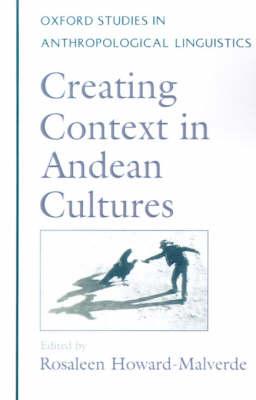Overview
A major concern in current anthropological thinking is that the method of recording or translating into writing a society's cultural expressions--dance, rituals, pottery, the social use of space, et al--cannot help but fundamentally alter the meaning of the living words and deeds of the culture in question. Consequently, recent researchers have developed more dialogic methods for collecting, interpreting, and presenting data. These new techniques have yielded much success for anthropologists working in Latin America, especially in their efforts to understand how economically, politically, and socially subordinated groups use culture and language to resist the dominant national culture and to assert a distinct historical identity. This collection addresses these issues of ""texts"" and textuality as it explores various Latin American languages and cultures.
Full Product Details
Author: Howard-Malverde
Publisher: Oxford University Press Inc
Imprint: Oxford University Press Inc
Volume: 6
Dimensions:
Width: 22.90cm
, Height: 1.90cm
, Length: 15.30cm
Weight: 0.440kg
ISBN: 9780195109146
ISBN 10: 0195109147
Pages: 272
Publication Date: 26 June 1997
Audience:
Professional and scholarly
,
Professional & Vocational
Format: Paperback
Publisher's Status: Active
Availability: To order

Stock availability from the supplier is unknown. We will order it for you and ship this item to you once it is received by us.
Reviews
Brings into view many far-from-obvious ways in which American peoples have put their societies into logically interesting order before their own eyes through coherent arrays of symbols. It also offers a fascinating tour of the boundary lands between specialized anthropological linguistics and the ethnography of expressive culture. --Anthropological Linguistics<br> The artices in the volume are well-written and show the hand of a skillful editor at work....I would highly recommend the use of the book in both undergraduate and graduate classes. Anyone working in the areas of Andean ethnography, ethnohistory, and linguistics will find it a very rich tome indeed. --Anthropological Quarterly<br>
<br> Brings into view many far-from-obvious ways in which American peoples have put their societies into logically interesting order before their own eyes through coherent arrays of symbols. It also offers a fascinating tour of the boundary lands between specialized anthropological linguistics and the ethnography of expressive culture. --Anthropological Linguistics<br> The artices in the volume are well-written and show the hand of a skillful editor at work....I would highly recommend the use of the book in both undergraduate and graduate classes. Anyone working in the areas of Andean ethnography, ethnohistory, and linguistics will find it a very rich tome indeed. --Anthropological Quarterly<br>
<br> Brings into view many far-from-obvious ways in which American peoples have put their societies into logically interesting order before their own eyes through coherent arrays of symbols. It also offers a fascinating tour of the boundary lands between specialized anthropological linguistics and the ethnography of expressive culture. --Anthropological Linguistics<p><br> The artices in the volume are well-written and show the hand of a skillful editor at work....I would highly recommend the use of the book in both undergraduate and graduate classes. Anyone working in the areas of Andean ethnography, ethnohistory, and linguistics will find it a very rich tome indeed. --Anthropological Quarterly<p><br>




